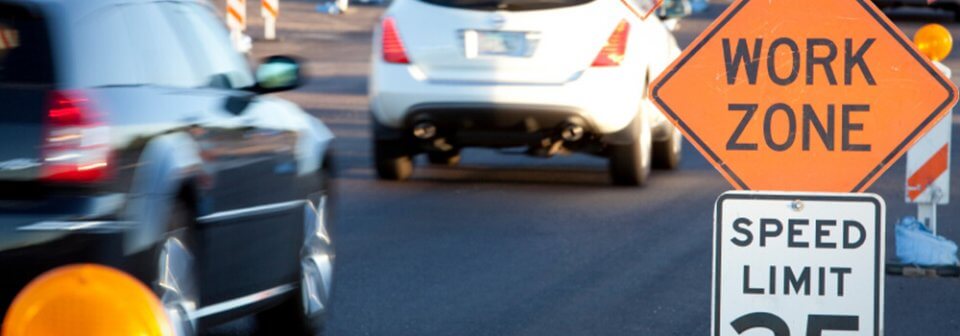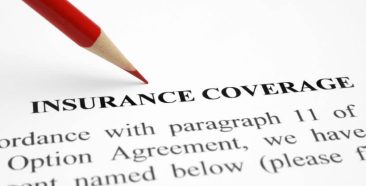
Road construction zones present unique challenges and hazards that require special attention from drivers. Construction zones often have reduced speed limits, lane closures, and potential hazards, making it crucial to prioritize construction zone safety.
We’ve all seen the signs when driving through highway construction zones – posted warnings that “traffic fines are doubled in work zones,” which increases the cost of your moving violation and most likely your auto insurance rates as well.
While that, in itself, should be enough to have drivers slow down and use caution, it isn’t. Maybe they should also let drivers know that ignoring these types of signs can double the danger of being injured or killed in those same work zones.
The collaboration between government authorities, construction companies, and drivers is essential in creating a safe environment for both workers and motorists. This blog provides valuable tips and insights to help drivers navigate construction zones with caution and minimize risks.
Understanding Construction Zone Hazards
Construction zones introduce various hazards that drivers should be aware of to ensure their safety and the safety of work zone crew members. Understanding these hazards is the first step towards safe navigation through construction zones.
Traffic-Related Hazards
Construction zones often involve:
- Changing lanes
- Lane closures
- Narrow lanes
- Changes in traffic patterns.
- Merging traffic
- Reduced visibility
These factors can increase the potential for accidents and collisions if drivers are not attentive. It is crucial to obey work zone signs and signals, follow instructions from flaggers (flagmen), and maintain a safe distance from other vehicles. By being aware of traffic-related hazards, drivers can adapt their driving behavior to ensure construction zone safety.
Environmental Hazards
Construction activities can lead to the presence of environmental hazards within work zones such as:
- Uneven road surfaces
- Loose gravel
- Debris
These may create driving challenges, especially at higher speeds. It is important to reduce speed and exercise caution when encountering these hazards. Additionally, staying alert for any sudden changes in road conditions can help drivers navigate the work zone area safely.
Importance of Construction Zone Safety Regulations
To maintain construction zone safety, various regulations and standards are in place. These regulations are designed to protect both workers and drivers in work zone areas. Organizations such as the Occupational Safety and Health Administration (OSHA) and the U.S. Department of Transportation (DOT) have established guidelines and requirements to ensure compliance with safety standards.
OSHA Construction Standards
OSHA has specific construction standards aimed at protecting workers in construction zones. These standards cover areas such as personal protective equipment, hazard communication, and fall protection. By adhering to these standards, construction companies can create a safer work environment, reducing the risk of accidents and injuries.
DOT Work Zone Traffic Control Regulations
The DOT has developed comprehensive work zone traffic control regulations to ensure safe driving while passing through construction zones. These regulations govern aspects such as work zone signage, traffic control devices, and temporary traffic control measures. Adhering to these regulations helps maintain a clear and organized flow of traffic, reducing the potential for accidents and confusion.
Safety Driving Tactics Mostly Ignored or Overlooked
Furthermore, to compound the issue, many of the safety tactics used by state departments of transportation to decrease the risk of accidents, such as posted signs to slow down, flaggers, and warning cones and barrels, are mostly ignored or simply overlooked by drivers passing through. This makes highway construction zones particularly hazardous for both motorists and workers who build, repair, and maintain our streets, bridges, and freeways.
According to the most recent statistics from the Centers for Disease Control and Prevention (CDC) and the National Institute for Occupational Safety and Health (NIOSH), there are an average of 40,000 injuries and over 600 fatalities each year from vehicle crashes in work zones. In 2012, the three states with the most motor vehicle crash fatalities in construction and maintenance work zones were Texas, California, and Florida – reporting at least 50 deaths each.
Sure, highway construction zones can be inconvenient, contribute to making you late to your destination, and raise your stress level. But getting frustrated and impatient will only accomplish one thing – increase your risk of injuring yourself or a construction worker just trying to do his job.
9 Tips for Road Construction Zone Safety
Navigating construction zones requires a proactive and cautious approach. By following these tips, drivers can contribute to construction zone safety:
1.Plan ahead
Stay informed about upcoming construction zones by checking traffic alerts and using navigation apps that provide real-time updates on roadwork activities.
2.Expect the unexpected
You never know what to expect in a work zone. Things can happen or change quickly when least expected. Construction equipment and workers can be on or cross the roadway and traffic can suddenly slow down or stop without warning.
3.Slow down when indicated and observe speed limits
Speeding accounts for more than one-third of all fatal accidents in work zones. If the signs indicate to reduce your speed, you should do so when approaching and driving through construction zones. Adhering to posted speed limits is crucial for safety.
4.Maintain a safe distance from the vehicle ahead
Rear-end collisions are common in work zones, accounting for 30 percent of accidents. Keeping a safe distance from the vehicle ahead of you, including construction equipment and workers, will greatly reduce your risk of an accident and watch your auto insurance rates go up.
Keep a safe following distance from the vehicle ahead to allow for unexpected stops or maneuvers. This extra space provides a buffer in case of sudden changes in traffic flow.
5.Minimize Distractions
Avoid driving distractions such as cell phone use, eating, or adjusting the radio while driving through construction zones. Focusing on the road and being attentive to changing conditions is essential for safe driving.
6.Obey road crew flagger instructions and posted work zone signs
Pay close attention to work zone signs, flaggers, and instructions from law enforcement or construction personnel. These individuals are there to assist drivers to maneuver safely through a work zone and stop you when the road ahead is blocked, so you can drive safely through the construction zone.
7.Remain alert and focused on driving
Now is not the time to change the music or engage in other distracted driving behaviors such as texting. Your attention should be on the road and only on the road while in the work zone.
8.Keep up with traffic
Nobody likes a “rubbernecker” or “looky-loo”. Keep up with the traffic flow. Don’t slow down to watch the roadwork or you could end up with a sore neck from getting rear-ended or be responsible for causing an accident behind you.
9.Be patient and stay calm
While being stuck in traffic can grate on your nerves, having to reduce your speed or stopping for a flagger for a few minutes to let heavy equipment cross the highway isn’t the end of the world. Remember, the crews are there to improve your driving experience by repairing or widening the road you’re on.
Promoting a Safe Driving Culture
Construction zone safety is a collective responsibility that extends beyond workers and construction companies. As drivers, we play a crucial role in creating a safe environment for everyone on the road.
By understanding construction zone hazards, complying with safety regulations, and implementing safe driving practices, we can minimize accidents, injuries, and even fatalities in construction zones. Make sure to prioritize construction zone safety to protect ourselves, the workers, and our vehicles.
Remember: getting to your destination should be secondary to your safety, because arriving in one piece trumps being a few minutes late. So, keep these construction work zone tips in mind and reduce your risk of an accident and higher car insurance.
Regardless of your driving record, Freeway Insurance can help you find cheap car insurance that fits your needs and budget. Request a free car insurance comparison online or over the phone at 800-777-5620.



